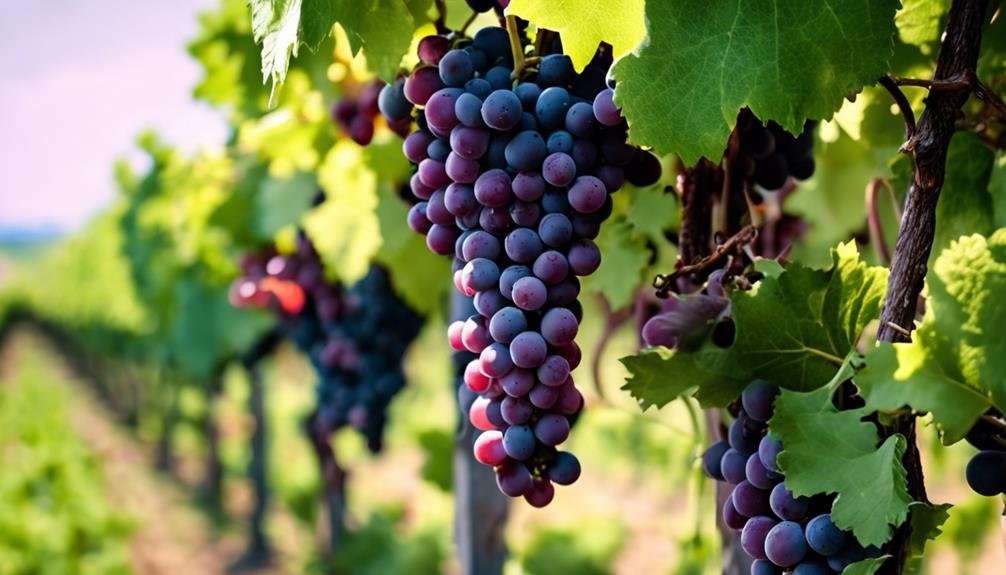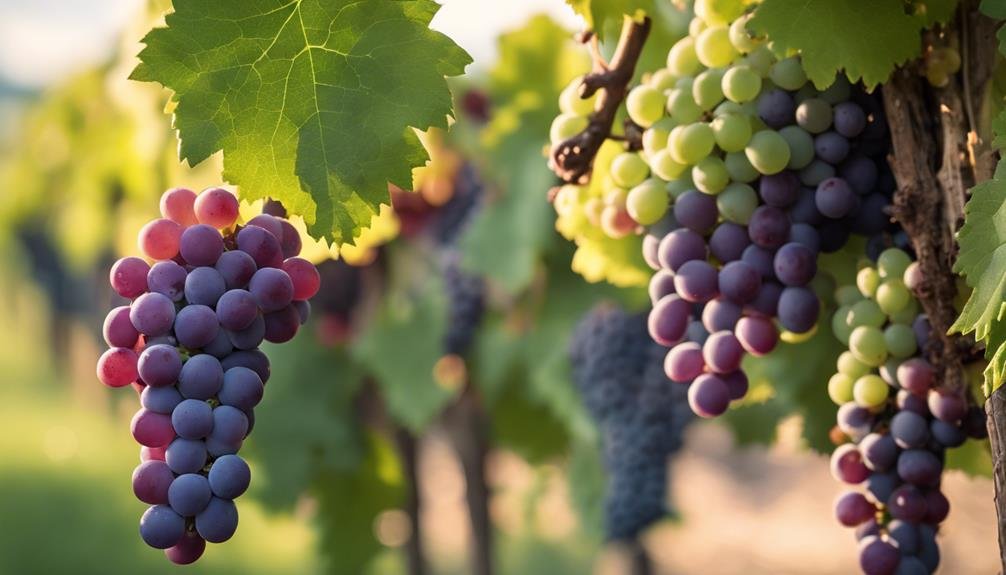Grapevines enter the pivotal veraison growth stage, a critical period in grape ripening. It's essential for peak fruit development and eventual wine quality. Careful vineyard management is crucial during this phase to guarantee grapes accumulate sugars, build aroma compounds, and shift to a sweeter composition. Practices like leaf trimming, sun exposure optimization, pest control, and water management play essential roles. Achieving balanced ripening is key for high-quality wine production, influencing sweetness and aroma complexity. Specific care practices vary for different regions and grape varieties. The veraison stage marks a critical juncture in grape maturation and wine quality enhancement.
Importance of Veraison Stage
The Veraison stage in grapevines is a pivotal moment that signifies the onset of grape ripening, marking an important shift in the grapevine's lifecycle. Vineyard management plays a significant role during this stage as it influences grape ripening. This period demands careful attention from winegrowers as the timing of veraison impacts the overall quality of the grapes.
Proper care and interventions, such as leaf trimming, are essential to guarantee excellent grape development and ripening. Grape ripening is a complex process where sugars and aroma compounds accumulate, while acid levels decrease post-veraison. Understanding and managing these changes are key factors in producing high-quality wines.
Different regions and grape varieties require specific care practices during this critical phase to achieve ideal ripeness for quality wine production.
Changes in Grape Development
Grape development undergoes significant transformations during the veraison stage, impacting the quality and characteristics of the resulting wine. As grapes progress through veraison, they begin to accumulate sugars, essential for the eventual alcohol content of the wine.
Concurrently, aroma compounds also start to build up, influencing the bouquet and flavor profile of the final product. These changes mark a shift from the initial acidic and hard grape composition to one that is sweeter and more aromatic.
Understanding these shifts in sugar levels and aroma accumulation is important for winemakers aiming to produce wines with balanced flavors and aromas. Proper management during this stage is crucial to ensure the grapes reach their peak ripeness for the best quality wine production.
Vineyard Practices During Veraison

Implementing strategic vineyard practices during veraison is essential for maximizing grape quality and ensuring peak ripening.
Leaf management plays a significant role during this stage, as proper trimming can optimize sun exposure to grape clusters, aiding in even ripening and preventing disease by improving air circulation.
Additionally, effective pest control measures are crucial to protect the ripening grapes from potential damage.
Water management is another key aspect to take into account, as providing the right amount of water at the right time can influence grape development and sugar accumulation.
Balancing sun exposure, leaf management, pest control, and water resources is essential for vineyard success during veraison, ultimately impacting the quality of the grapes harvested for winemaking.
Impact on Wine Quality
Enhancing wine quality during the veraison stage necessitates meticulous attention to vineyard practices and grape development. Sugar accumulation and aroma compounds play pivotal roles in shaping the final product.
- Sugar accumulation: As grapes progress through veraison, sugar levels increase, contributing to the sweetness of the eventual wine.
- Aroma compounds: The maturation of aroma compounds during veraison influences the complexity and fragrance of the wine.
- Balanced ripening: Ensuring uniform ripening of grapes is essential to produce high-quality wine that harmoniously integrates sugar levels and aroma compounds.
Addressing Uneven Ripening

Addressing the challenge of uneven ripening in grape varieties demands precise vineyard management techniques to guarantee balanced fruit development. Vineyard challenges arise when grape varieties like Pinot Noir, Sangiovese, Malbec, Gewürztraminer, and Zinfandel exhibit uneven ripening, potentially resulting in unbalanced wines.
These varieties are known to be challenging to grow due to their susceptibility to uneven ripening, a phenomenon that impacts overall grape quality. To manage uneven ripening effectively, vineyard managers must employ strategic ripening management practices tailored to each specific grape variety.
Frequently Asked Questions
How Does Veraison Affect the Color Development in White Grapes?
Veraison triggers color changes in white grapes through processes like skin maceration and anthocyanin accumulation. This shift from green to translucent hues impacts grape quality and is essential for winemaking, guiding vineyard practices for best outcomes.
What Are the Key Factors Influencing the Timing of Veraison?
Key factors influencing the timing of veraison include climate, grape variety, and vineyard management practices. Varieties like Pinot Noir and Gewürztraminer are known for uneven ripening. Nets protect grapes; timing veraison impacts ripening.
Do All Grape Varieties Experience the Veraison Stage?
All grape varieties experience veraison, a pivotal stage in grape maturation. Varietal differences influence the ripening process, impacting factors like sugar and acidity levels. Recognizing the veraison significance aids winegrowers in determining ideal grape ripeness for quality wine production.
How Do Nets Help Protect Grapes During Veraison?
Nets are like guardians shielding grape clusters during veraison, offering benefits like shading. They safeguard against bird damage, ensuring a fruitful harvest. These protective measures play a crucial role in preserving grape quality and quantity.
Can Vineyard Management Practices Mitigate Uneven Ripening in Grapes?
Vineyard management practices like canopy management play a crucial role in mitigating uneven ripening in grapes. Adjusting crop yield, optimizing harvest timing based on sugar levels, and addressing varietal needs through proper care can help achieve balanced ripening for quality grape production.
Conclusion
In summary, the veraison stage in grapevines marks a pivotal turning point in their development, impacting grape quality and ultimately wine production. Understanding the timing and effects of veraison is essential for winegrowers to adjust vineyard practices accordingly and achieve ideal fruit maturity.
With its significance in addressing challenges like uneven ripening, veraison serves as a key indicator for ensuring the successful growth and ripening of grape varieties, highlighting its essential role in the winemaking process.